JavaScript seems to be disabled in your browser. For the best experience on our site, be sure to turn on Javascript in your browser.

Effective Communication in the Workplace

Source: https://pixabay.com/vectors/social-media-connections-networking-3846597/ is in the Public Domain at Pixabay.com. Retrieved 07.05.2022.
Effective workplace communication helps maintain the quality of working relationships and positively affects employees' well-being. This article discusses the benefits of practicing effective communication in the workplace and provides strategies for workers and organizational leaders to improve communication effectiveness.
Workplace Communication Matters
Effective workplace communication benefits employees' job satisfaction, organizational productivity, and customer service (Adu-Oppong & Agyin-Birikorang, 2014). We summarized Bosworth's (2016) and Adu-Oppong and Agyin-Birikorang's (2014) works below related to the benefits of practicing effective communication in the workplace.
- Reduces work-related conflicts
- Enhances interpersonal relationships
- Increases workers' performance and supervisors' expectations
- Increases workforce productivity through constructive feedback
- Increases employee engagement and job satisfaction
- Builds organizational loyalty and trust
- Reduces employees' turnover rate
- Facilitates the proper utilization of resources
- Uncovers new employees' talents
Strategies to Improve Communication Effectiveness
Effective communication is a two-way process that requires both sender and receiver efforts. We summarized research works and guidelines for good communication in the workplace proposed by Cheney (2011), Keyton (2011), Tourish (2010), and Lunenburg (2010).
Sender's strategies for communication planning
- Clearly define the idea of your message before sharing it.
- Identify the purpose of the message (obtain information, initiate action, or change another person's attitude)
- Be aware of the physical and emotional environment in which you communicate your message. Consider the tone you want to use, the configuration of the space, and the context.
- Consult with others when you do not feel confident or comfortable communicating your message.
- Be mindful of the primary content of the message.
- Follow-up previous communications to verify the information.
- Communicate on time, avoid postponing hard conversations, and be consistent.
- Be aware that your actions support your messages and be coherent in your verbal and behavioral communication style.
- Be a good listener, even when you are the primary sender.
Receiver's strategies during a conversation
- Show interest and attitude to listen.
- Listen more than talk.
- Pay attention to the talker and the message, avoiding distractions.
- Be patient and allow the talker time to transmit the message.
- Be respectful and avoid interrupting a talker.
- Hold your temper. An angry person takes the wrong meaning from words
- Go easy on argument and criticism.
- Engage in the conversation by asking questions. This attitude helps develop key points and keep a fluid conversation.
Effective communication practices are essential for any successful team and organization. Organizational communication helps to disseminate important information to employees and builds relationships of trust and commitment.
Key points to improve communication in the workplace
- Set clear goals and expectations
- Ask clarifying questions
- Schedule regular one-on-one meetings
- Praise in public, criticize in private
- Assume positive intent
- Repeat important messages
- Raise your words, not your voice
- Hold town hall meetings and cross-functional check-ins.
Adu-Oppong, A. A., & Agyin-Birikorang, E. (2014). Communication in the Workplace: Guidelines for improving effectiveness. Global journal of commerce & management perspective , 3 (5), 208–213.
Bosworth, P. (2021, May 19). The power of good communication in the workplace . Leadership Choice. Retrieved May 18, 2022.
Cheney, G. (2011). Organizational communication in an age of globalization: Issues, reflections, practices . Waveland Press.
Keyton, J. (2011). Communication and organizational culture: A key to understanding work experience . Sage.
Tourish, D. (2010). Auditing organizational communication: A handbook of research, theory, and practice . Routledge
Lunenburg, F. C. (2010). Communication: The process, barriers, and improving effectiveness. Schooling , 1 (1), 1-10.

- Adult leadership
- Volunteerism
- Volunteer management
You may also be interested in ...

Diferencias culturales en el ambiente laboral

Consejos Para Desarrollar una Filosofía Personal de Liderazgo

Importance of Incorporating Local Culture into Community Development

Conducting Effective Surveys - 'Rules of the Road'

Conflict Styles, Outcomes, and Handling Strategies

Employee Disengagement and the Impact of Leadership

Dealing with Conflict

Developing Self-Leadership Competencies

Diversity Training in the Workplace

Plum Pox Eradication in PA - A Blueprint for Future Plant Disease Outbreaks
Personalize your experience with penn state extension and stay informed of the latest in agriculture..
- Product overview
- All features
- Latest feature release
- App integrations
CAPABILITIES
- project icon Project management
- Project views
- Custom fields
- Status updates
- goal icon Goals and reporting
- Reporting dashboards
- workflow icon Workflows and automation
- portfolio icon Resource management
- Capacity planning
- Time tracking
- my-task icon Admin and security
- Admin console
- asana-intelligence icon Asana AI
- list icon Personal
- premium icon Starter
- briefcase icon Advanced
- Goal management
- Organizational planning
- Campaign management
- Creative production
- Content calendars
- Marketing strategic planning
- Resource planning
- Project intake
- Product launches
- Employee onboarding
- View all uses arrow-right icon
- Project plans
- Team goals & objectives
- Team continuity
- Meeting agenda
- View all templates arrow-right icon
- Work management resources Discover best practices, watch webinars, get insights
- Customer stories See how the world's best organizations drive work innovation with Asana
- Help Center Get lots of tips, tricks, and advice to get the most from Asana
- Asana Academy Sign up for interactive courses and webinars to learn Asana
- Developers Learn more about building apps on the Asana platform
- Community programs Connect with and learn from Asana customers around the world
- Events Find out about upcoming events near you
- Partners Learn more about our partner programs
- Asana for nonprofits Get more information on our nonprofit discount program, and apply.
Featured Reads

- Collaboration |
- 12 tips for effective communication in ...
12 tips for effective communication in the workplace

Effective communication transcends simple information exchanges. Understanding the emotions and motives behind the given information is essential. In addition to successfully conveying messages, it's important to actively listen and fully understand the conversation, making the speaker feel heard and understood.
Today, we’re in almost constant contact with our coworkers. You might not put a lot of thought into saying “hi” to your coworker, grabbing virtual coffee with a remote team member, or sending a gif of a cat wearing pajamas to your team—and that’s ok. Even though you’re communicating at work, there’s a difference between these types of messages and communication in the workplace.
Communication in the workplace refers to the communication you do at work about work. Knowing when and how to effectively communicate at work can help you reduce miscommunication, increase team happiness, bolster collaboration, and foster trust. Teams that know how to communicate effectively about work are better prepared for difficult situations. But building good communication habits takes time and effort—and that’s where we come in. Here are 12 ways to take your workplace communication skills to the next level.
What is effective communication?
Effective communication is the exchange of ideas, thoughts, opinions, knowledge, and information so that the message is received and comprehended clearly and purposefully. When we communicate effectively, all stakeholders are fulfilled.
Developing effective communication skills requires a delicate balance of active listening, verbal communication, nonverbal cues, body language, and emotional intelligence to ensure messages are clearly transmitted and understood.
It's about more than just talking; effective communication involves listening skills and a deep understanding of interpersonal dynamics. Individuals can use these communication skills to bridge gaps, make informed decisions, and strengthen relationships.
What does “workplace communication” mean?
Communication in the workplace can happen face-to-face, in writing, over a video conferencing platform, on social media, or in a group meeting. It can also happen in real time or asynchronously , which happens when you’re communicating about work over email, with recorded video, or on a platform like a project management tool . Some examples of workplace communication include:
Team meetings
1:1 feedback sessions
Receiving information
Communicating about project status or progress
Collaboration on cross-functional tasks
Nonverbal communication
Collaboration Report: How the most effective teams in the world collaborate
Explore key traits that have made the most effective teams in the world successful: their strategies, techniques, and tips for working well together.

What makes communication effective?
Now that you know what type of communication can be included in workplace communication, how do you start getting better at it? There are a few key tenets of effective communication that you can use, no matter what type of communication it is. In particular, good communication:
Aims for clarity. Whether you’re sending a Slack message, drafting an email, or giving an off-the-cuff reply, aim to be clear and concise with your communication.
Seeks to solve conflicts, not create them. In the workplace, we're often involved in problem solving and collaborating on projects or tasks. Good communication in the workplace can involve bringing up blockers or providing feedback—but make sure the goal is to get to a better place than where you are now.
Goes both ways. Every instance of effective communication in the workplace represents an exchange of information—even when the information is communicated solely through nonverbal cues.
Benefits of effective communication in the workplace
Clear, effective workplace communication can:
Boost employee engagement and belonging
Improve interpersonal skills and emotional intelligence
Encourage team buy-in
Increase productivity
Build a healthy workplace and organizational culture
Reduce conflict
Increase retention
7 tips for more effective communication in the workplace
Effective communication in the workplace is all about where, how, and when you’re communicating. Try these seven tips to develop better communication skills.
1. Know where to communicate—and about what
Communication happens in many different forms—face-to-face, over email, via instant messages, and in work management platforms. To be most effective, make sure you’re following communication guidelines and messaging about the right things in the right places.
Sometimes, knowing where to communicate is half the battle. Your company may have different communication tools , which makes knowing which tool to use all the more important. Which tool is appropriate for your question or comment? Do you need to communicate in real time, or is it ok to send an asynchronous message? If you’re not sure, ask a team member or manager where you should be sending different types of messages. It is important for everyone to be on the same page. For example, at Asana, we use:
2. Build collaboration skills
Collaboration is the bedrock of effective teamwork. In order to build strong team collaboration skills , you need to practice open and honest communication. This doesn’t necessarily mean always agreeing on things—knowing how to disagree and work through those differences is a key part of collaboration, too.
Collaboration and communication skills are kind of a “chicken and egg” scenario. You can build good collaboration by communicating effectively, but knowing how to collaborate is a key component of strong communication. Essentially, this just means you’ll have to practice improving both collaboration and communication skills over time. As you improve team collaboration, you’ll get better at conveying information and opinions in a work environment—and as a result, that honest communication will make collaboration feel more effortless.
3. Talk face-to-face when you can
Perhaps the most tried-and-true way to avoid miscommunication is to talk face-to-face. If your team is virtual, speaking via video conferencing also works. Eye contact is particularly important if you know a conversation is going to be hard. Tone can be difficult to communicate through writing so ideally, you want your team member to be able to see your facial expressions and body language.
If your team is remote or distributed, communicating via a phone call instead of a video conference could work as well. Video conferencing fatigue is real, and it can make collaboration and communication particularly difficult for remote teams. Communicating over the phone reduces some of the visual strain, while still giving you the ability to hear your team member’s voice and tone.
4. Watch your body language and tone of voice
Communication isn’t just about what you say—it’s also about how you say it. Make sure you aren’t crossing your arms or coming off as curt. Oftentimes, your body language may have nothing to do with the current situation—maybe you’re tired or stressed about something in your personal life. But your team members, who might not have that context, could see your actions and assume you’re angry or upset about something. Particularly for hard conversations, try to relax your body language and facial expressions to avoid giving off any unintentional cues.
5. Prioritize two-way communication
Listening skills are just as important to communication in the workplace as talking. Part of being a collaborative team member is listening to other people’s ideas instead of just trying to put your own ideas out there.
There are two common types of listening : listening to reply and listening to understand. When you listen to reply, you’re focusing on what you’re going to say next, rather than what the other person is saying. With this type of listening, you risk missing key information or even repeating what the other person just said.
Instead, try active listening—that is, listen to what the other person has to say without thinking about how you’re going to reply. If you do think of something you want to say, jot it down so you can go back to listening to understand , instead of trying to remember the thing you want to say next.
6. Stick to facts, not stories
“Facts vs. stories” is a technique recommended by the co-founder of the Conscious Leadership Group, Diana Chapman. In this case, “facts” are things that have actually happened—things that everyone in the room would easily agree on. A “story,” on the other hand, is your interpretation of the situation.
For example, say your manager gives you live feedback during a small team meeting. That is a fact. You weren’t expecting the feedback, and you feel like your manager shared the feedback—instead of saving it for your 1:1—because they’re dissatisfied with your work. This is a “story” because you have no way of knowing if it is true or not.
Stories are inevitable—we all create stories from facts. But try to separate stories from facts, and avoid acting on stories until you’re able to validate them. For example, in this case, you might want to talk to your manager during your next 1:1 and ask why they shared feedback in a team meeting.
7. Make sure you’re speaking to the right person
Effective workplace communication is as much about who you’re talking to as it is about what you’re saying. Poor communication often occurs when you’re talking to the wrong people or trying to share information in the wrong setting.
To avoid this, make sure the right people are in the room or receiving the message. If you aren’t sure who that would be, go through an exercise to identify any important project stakeholders who might be missing.
5 tips to build effective communication skills in the workplace
If you’re a leader, you have the power to set and establish communication conventions on your team. Effective communication skills can build healthy company culture , foster trust among your employees, and break down silos between cross-functional teams. Here’s how:
1. Address any underlying changes
Before you start improving your team’s communication skills, ensure there are no underlying issues that keep everyone from communicating honestly. Does everyone feel comfortable talking openly? Is there anything that might make a team member feel like they can’t be their full selves?
One of the most valuable things you can do as a leader is to make sure your employees feel comfortable showing up to work as their whole selves (or as much of themselves as they want to bring). Whether that means voicing disagreements, talking about their passions outside of work, or being honest about what type of communication works best for them, make sure to understand each team member’s needs and ensure they’re being met in the team environment.

One theme that kept coming up in our employee engagement surveys was that we could improve information sharing and communication across the organization, so we looked for a way to do that.”
2. Frequently ask for feedback
If you don’t ask for feedback on your communication style, you may never get it. Even though communication in the workplace impacts every other interaction, team members might not immediately think of it as something to provide feedback on. By asking your employees for feedback on your communication style, you can continue to improve and develop clear communication strategies for your team.
3. Understand team communication styles
Another effective way to communicate with your team is to ask them how they want to communicate. Communication preferences shouldn’t be a secret—or a guessing game—and knowing off the bat if your team members prefer video conferences or phone calls, early morning meetings, or afternoon jam sessions can help you create an environment where they can thrive.
Important questions to ask include:
Are they an early bird or a night owl?
Do they like structured meetings or prefer free-flow brainstorming sessions?
Do they do their best thinking out loud, on the spot, or on paper?
What personality type do they identify with: introvert, extrovert, or ambivert?
Do they feel like they know their team members, or would they prefer more team bonding activities?
What types of meetings or tasks are most energizing for them?
4. Make time for team building or icebreakers
Getting to know your team is critical to developing good communication skills. It’s particularly important to make time to get to know your team outside of a workplace setting. Icebreaker questions can help bring an element of personality and fun to every meeting, so consider starting with a light chat before diving into your meeting agenda.
5. Set the tone
Remember: the way you communicate and collaborate will impact your entire team. It’s up to you to set the standard for open and clear communication in the workplace. Once you establish this standard, your team will follow suit.
Every few months, make a note to follow up with how everyone is feeling about team communication. Are there any habits that have cropped up in the last few months that you want to cull or encourage? Regularly thinking about how your team communicates—instead of “setting and forgetting” your team practices—can help you be more intentional about your communication methods.
As an organization grows, communication starts to bottleneck. At Hope for Haiti, we’ve seen those inefficiencies hurt us: when we can’t run like a well-oiled machine, we’re not serving as many people as we could be—and it’s our responsibility to improve upon that.”
More types of workplace communication
Most discussions about communication in the workplace assume the “workplace” is in person. But there are various forms of communication across different locations—from global offices to remote teams. Most effective communication best practices still apply to any type of team, but there are a few additional considerations and best practices you can use to help team members truly connect.
Distributed teams
Distributed teams work across multiple national or global offices. These teams might span different time zones and languages, and each office will have its own culture and habits. Don’t expect each distributed team to communicate in the same way—in fact, one of the advantages of distributed teams is the variety of thought you’re exposed to by working with teammates from all over the world.
If you work on a distributed team, it’s critical to over-communicate so that team members in different time zones and offices stay in the loop. Make sure to document everything in a central source of truth that team members can access when they’re online, and look for a tool that updates in real-time so no one has to slow down due to information lag.
Keep in mind that time zones might affect how people come to a conversation. Try to schedule meetings when everyone is available, or offer recordings and notes if team members can’t make it. It’s also critical to double check that the right people are in the loop, and that they aren’t just being left out because they’re in a different office than the majority of your team.
Online coworkers
If you’re working with a virtual team, it’s critical to establish where you’re going to communicate and how frequently. Knowing exactly what each communication tool should be used for can help team members feel connected—even while they’re remote.
While working remotely, we’ve had to re-learn how to communicate in many ways. Slack, Asana, and integrations between these tools has replaced or supplemented a lot of in-person ways we used to communicate.”
Remote team members can feel isolated and disconnected from one another, so consider doing an exercise with your entire team about preferred business communication habits. Some team members might love cold calls, while others might prefer scheduled meetings with concise agendas. Because team members have fewer chances to interact in person, it’s critical to establish these forms of communication as a team so you can keep the communication channels open.
Finally, make sure to bring team members in for regular team bonding events. Whether you’re doing icebreaker activities at the beginning of every meeting or scheduling some time to just chat at the end of each week, dedicated team time can help team members connect, no matter where they’re dialing in from.
The cherry on top of effective workplace communication
The last component of great communication is having a central source of truth for all of your communication and work information. Using a centralized system like a work management tool can help you coordinate work across all levels of your team. Learn more about how work management makes project coordination and communication easier in our introduction to work management article .
FAQ: Effective communication in the workplace
What are the best ways of communicating with your work colleagues.
The best ways of communicating with your work colleagues involve concise, respectful, and timely exchanges. This can be achieved through various channels, such as emails, instant messaging, face-to-face meetings, and video calls. Selecting the right medium based on the context of your communication (e.g., using emails for formal requests or Slack for quick queries) and ensuring you're concise and to the point can enhance the effectiveness of your communication.
Why is effective communication important?
Effective communication ensures that information is accurately conveyed and understood, resulting in improved efficiency, fewer misunderstandings, and better working relationships. It promotes teamwork, decision-making, and problem solving, which makes effective communication a cornerstone of successful operations and a positive work environment.
What constitutes effective communication?
Effective communication is characterized by clarity, conciseness, coherence, and considerateness, also known as the 5 Cs of communication. It means the message is delivered in a clear and understandable manner, is direct and to the point, logically organized, and sensitive to the receiver's needs and perspectives. It also involves active listening, openness to feedback, and the ability to adjust or paraphrase the message according to the audience and context.
How can you become an effective communicator?
To become an effective communicator, focus on clarity and brevity in your messages, actively listen to others, and provide constructive feedback. Pay attention to both verbal and nonverbal cues, such as body language and tone, to ensure your message is received as intended. Practice empathy by considering the receiver's perspective, and be open to feedback to continuously improve your public speaking skills.
Related resources

10 tips to improve nonverbal communication

Scaling clinical trial management software with PM solutions

How to build your critical thinking skills in 7 steps (with examples)

4 ways to establish roles and responsibilities for team success
How it works
Transform your enterprise with the scalable mindsets, skills, & behavior change that drive performance.
Explore how BetterUp connects to your core business systems.
We pair AI with the latest in human-centered coaching to drive powerful, lasting learning and behavior change.
Build leaders that accelerate team performance and engagement.
Unlock performance potential at scale with AI-powered curated growth journeys.
Build resilience, well-being and agility to drive performance across your entire enterprise.
Transform your business, starting with your sales leaders.
Unlock business impact from the top with executive coaching.
Foster a culture of inclusion and belonging.
Accelerate the performance and potential of your agencies and employees.
See how innovative organizations use BetterUp to build a thriving workforce.
Discover how BetterUp measurably impacts key business outcomes for organizations like yours.
Daring Leadership Institute: a groundbreaking partnership that amplifies Brené Brown's empirically based, courage-building curriculum with BetterUp’s human transformation platform.

- What is coaching?
Learn how 1:1 coaching works, who its for, and if it's right for you.
Accelerate your personal and professional growth with the expert guidance of a BetterUp Coach.
Types of Coaching
Navigate career transitions, accelerate your professional growth, and achieve your career goals with expert coaching.
Enhance your communication skills for better personal and professional relationships, with tailored coaching that focuses on your needs.
Find balance, resilience, and well-being in all areas of your life with holistic coaching designed to empower you.
Discover your perfect match : Take our 5-minute assessment and let us pair you with one of our top Coaches tailored just for you.

Research, expert insights, and resources to develop courageous leaders within your organization.
Best practices, research, and tools to fuel individual and business growth.
View on-demand BetterUp events and learn about upcoming live discussions.
The latest insights and ideas for building a high-performing workplace.
- BetterUp Briefing
The online magazine that helps you understand tomorrow's workforce trends, today.
Innovative research featured in peer-reviewed journals, press, and more.
Founded in 2022 to deepen the understanding of the intersection of well-being, purpose, and performance
We're on a mission to help everyone live with clarity, purpose, and passion.
Join us and create impactful change.
Read the buzz about BetterUp.
Meet the leadership that's passionate about empowering your workforce.

For Business
For Individuals
Communication is key in the workplace. Here's how to improve

Jump to section
Why is communication important in the workplace?
7 common types of communication in the workplace
The benefits of good communication in the workplace
8 reasons to work on your communication skills
8 ways to develop communication skills at work
How to improve communication when working remotely.
Communication, communication, communication. We all know it’s important, but communication skills can be challenging to develop and implement at work. The rise of remote and hybrid work hasn’t made it any easier, either.
Yet, effective communication at work can be transformative for individuals, teams, and businesses. We’re here to show you why communication is important in the workplace and how to start building your and your team’s communication skills today.
Why is effective communication important in the workplace?
Communication in the workplace is important because it boosts employee morale, engagement, productivity, and satisfaction. Communication is also key for better team collaboration and cooperation. Ultimately, effective workplace communication helps drive better results for individuals, teams, and organizations.
To take it a step further, specifically as a manager, building good communication skills has profound short- and long-term benefits for your organization. An effective communicator is able to motivate their team to get more done with better results and fewer misunderstandings. And who doesn’t want fewer misunderstandings?
All of these things can contribute to the company’s success — and to your own personal success as a leader.
Not all work communication is made equal. We’ve all had the experience of sitting through a boring, lengthy meeting with the thought, “This should have been an email.”
Different communication channels are ideal for different types of communication. Depending on the type of information being conveyed, those different channels can enhance — or detract — from how it is received. An effective communicator will develop different skills and tools to match the type of communication needed.
1. Leadership communication
Leaders often deliver one-way communications to their teams. The goal may be to inform or update, such as a memo about a new company policy or a change in direction. Leaders also often communicate to persuade, encourage, and inspire commitment. They often communicate through stories more than data.
2. Upward communication
Managers (and team members) often have to communicate with their own managers and with other leaders who are not in their direct chain of command. These may take the form of memos/emails, reports, or a slot in a standing meeting. Regardless of the format, these types of communications should be considered more formal.
3. Updates
Since they’re brief by nature, updates often fall short of being a type of strong communication. Use a visual tracker or dashboard to carry the load, and save your verbal or written commentary for drawing the audience’s attention to what is most important — typically, what requires action or further involvement from them. This might include surprises, obstacles, and potential risks, as well as wins.
4. Presentations
These formal communication events tend to receive the lion’s share of attention, for good reason. Presentations are communication tools that are typically aimed at a larger audience with higher stakes. They have objectives like informing, influencing, and persuading. In addition, many people fear public speaking , and thanks to TED and other series, we have a high expectation for entertainment as well as insight.
5. Meetings
Meetings, whether large or small, are a critical part of a workplace’s internal communication strategy . They’re also one of the least understood and most overused types of communication. Effective meetings build synergy between teams and quickly communicate information that would have a high potential to be misunderstood in another format (like email). The best meetings are highly collaborative and leave participants feeling energized, not drained.
6. Customer communications
Communicating with customers can run the entire gamut discussed above, from one-offs to face-to-face , virtual, spoken, or written, formal to ad hoc. In general, all of the considerations of communication among employees go double for customers. Be deliberate and plan your messages to provide what your customer needs, in the way they prefer, and create a positive impression for the company and the product.
7. Informal interactions
Informal communications include the emails and chats you engage in all day: making requests, asking for information, responding to requests, and giving or receiving support and guidance. In addition to moving the work of the organization forward, these informal communications have secondary objectives of forming social connections , building culture, establishing trust , and finding common ground.
.webp?width=800&height=534&name=woman%20communicating%20with%20male%20coworker%20at%20desk%20(1).webp)
When employees are directly involved in work products and initiatives, it helps to foster a sense of ownership in the company’s future. It also makes them want to work to improve things like the company’s profitability, customer satisfaction, and brand.
Let’s take a look at some ways that building your communication skills cascades down through your organization — and directly impacts its bottom line.
1. Better engagement
Better communication results in greater employee engagement , which is a key metric for employee productivity and potential retention. It reinforces that your people are key contributors and people who the company values for their unique skills and experience. In other words, their contribution — and input — truly make a difference.
2. Increased morale
Team members with low job satisfaction take more time off of work, are less productive when in-office, and often negatively impact the productivity of other employees when they are present. However, when an employee has an understanding of the work that they have to do and how it connects to the overall success of the team, they bring more energy and pride to their work.
3. Improved productivity
Better communication techniques help employees to better comprehend their roles, which in turn helps employees perform their assigned duties better. Resources and time can be saved through these techniques, therefore getting more work done and reducing stress .
4. Reduced churn
From customer support representatives to senior technical staff, experience equals value to customers and to the company. And no organization wants to waste the huge costs of recruiting and training good employees by having them leave quickly. As a key factor in employee satisfaction and engagement, communication adds value to the organization by reducing the turnover of skilled and seasoned staff members.
5. Greater loyalty
Longer-term, keeping employees for many years can add strength to the company and impact the bottom line. Many jobs require years of experience before an employee has sufficient expertise to drive innovation, solve critical problems , and lead others. How an employee feels toward the company — based on how they feel they are treated and valued as individuals — impacts how loyal they will be.
6. Better collaboration
Most companies today use technologies that don’t require team members to be in the same room, the same building, or even the same country. This shift presents new communication challenges, which means managers can facilitate collaboration by helping groups communicate effectively when using the latest technologies.
7. Fewer workplace conflicts
Many conflicts originate with miscommunication . Poor communication can create negative relationships or even toxic or hostile work environments . Building clear communication can improve company culture and prevent misunderstandings between managers and employees . This includes honing and refining communication styles that focus on listening to others, having empathy, and considering individual differences.
8. Greater motivation
Psychologists have found that unless people understand the “why” of a concept, they will be less likely to understand or remember it. The same goes for many aspects of people’s work lives. As a manager, one key communication skill is hearing the “why” and following up with a “because.” This approach will help you motivate employees .
.webp?width=800&height=533&name=coworkers%20meeting%20communicating%20and%20shaking%20hands%20in%20an%20office%20(1).webp)
Now that you understand the importance of good communication at work, you need to know how to develop those skills. Remember: effective communication is about active listening — while it may seem counter-intuitive, a “listener-first” approach will often help you structure the delivery of your message.
Here are 8 more tips for developing your communication skills .

1. Think it through
There are many communications frameworks, but if you want to improve your communication skills, start by getting in the habit of thinking through these 5 questions for any communication you create:
- Why are you communicating?
- Who is the receiver, audience, or participant?
- What is your goal or objective?
- What do you want the recipient to do as a result of the communication?
- What format will best accomplish your goal?
If you struggle to answer these five questions, you should spend some additional time thinking about how and why you’re communicating. Then, test your understanding with co-workers or your manager.
2. Give it time
Plan what you want to say and review your communication to make sure it’s actually doing the job you need it to. For written communications, especially, this means: revise, revise, revise. Remember, great communication might seem effortless, but it rarely is.
3. Make it easy
Workplace communication almost always has a larger goal. People are busy. Don’t make them work too hard to understand what you are saying and what you need them to do. State your objective and main point from the beginning of a presentation or written communication so that your audience knows where you’re going. Then fill in the details.
4. Simplify
While you don’t want to condescend or “dumb it down,” in everyday work communications, be mindful of not making the other party work too hard to understand. Find a clear, simple phrasing to encapsulate your point. Repeat it at the beginning, middle, and end, and consider using a simple visual or metaphor to make your point clear and memorable.
5. Experiment and diversify
Work on developing different tactics for different communication needs. Focus on experimenting with one aspect of your communication at a time. For example, spend a week paying extra attention to how you structure informal communications. Then spend a week trying different structures for formal meetings or updates.
6. Practice and reflect
Be deliberate about reflecting on what goes well and what doesn’t in your day-to-day communications. Maybe an email to your manager didn’t go well. Can you see how it might have been misinterpreted? What would you do differently next time? Similarly, if a conversation with a co-worker didn’t yield the expected results, try to identify whether you clearly communicated what you needed.
7. Consider the full package
Consider recording yourself through a few interactions to gain insight into what your full package is communicating in your daily interactions with your team. Do you make eye contact? Is your facial expression relaxed and confident, or tense? How’s your body language? Do you leave time for questions and clarification?
8. Seek feedback
Ask a few trusted co-workers and your manager to rate your communication skills. Start by asking them to rate (i.e., on a scale of 1-10) your written and spoken communication separately. Then ask these 3 questions:
- What one thing should I start doing to communicate better with you?
- What one thing should I stop doing in my communications with you?
- What one area or skill should I work on to improve how I communicate in this organization?
.jpg?width=2120&height=1414&name=woman%20in%20yellow%20and%20headphones%20smiling%20on%20virtual%20call%20(1).jpg)
Communicating well is even more important for leaders and managers during remote work . Doing it well can help build trust and connection with your team and avoid some of the frustrations that come from miscommunication.
Here are a few areas to consider to improve remote communication:
1. Clarify expectations
State expectations upfront and repeat them at the end of a communication . Even better, ask the other person to restate their understanding of your expectations.
2. Engage in 2-way flow
Being remote can make it easier for employees to check out and disengage. Be deliberate and creative about giving others a role in communication. Ask questions, use polling and ranking tools, and solicit responses in the form of emojis, gifs, or one-word descriptors.
3. Remember the power of in-person
A lot can be misinterpreted in the flat space of text without additional cues like tone of voice and facial expression. Don’t default to communicating solely through text or chat. A well-crafted team Zoom call or in-person meeting can establish a better connection and shared understanding, giving others a chance to surface areas of misalignment.
4. Focus on quality
People may feel protective of their time when working remotely, so make sure that live events are well-thought-out. Send agendas, meeting objectives, or background reading ahead of time to help people prepare to have productive conversations.
5. Create an informal space
Assuming good intentions and a sharing culture are both foundational for effective day-to-day communication at work. That said, they’re hard to build and maintain without opportunities for casual interaction like happy hours or non-work Slack channels .
6. Show you care
You don’t have to spend a lot of time checking in with people and asking about their personal lives. But, now more than ever, it’s worth reminding yourself that the recipients of your communications are real people who have their own challenges, distractions, hopes, and fears. Before getting on a video call or firing off an email, try picturing that person on the other end.
Start communicating better today
Every year communication tops the list of skills in demand by employers. There's a reason. Communication is what makes our professional and personal relationships go smoothly. It's how we show care, catalyze change, and get things done. Business coaching for your team and yourself can help with this skill.
That's reason enough to improve — and keep improving — these important skills. Luckily, we can all learn to communicate better.
Understand Yourself Better:
Big 5 Personality Test
Allaya Cooks-Campbell
With over 15 years of content experience, Allaya Cooks Campbell has written for outlets such as ScaryMommy, HRzone, and HuffPost. She holds a B.A. in Psychology and is a certified yoga instructor as well as a certified Integrative Wellness & Life Coach. Allaya is passionate about whole-person wellness, yoga, and mental health.
7 Critical teamwork skills and how to develop them
What is nonverbal communication 10 different types (with examples), how to handle gossip in the workplace and encourage communication, why face-to-face communication matters (even with remote work), improve your interpersonal communication skills with these 6 tips, leverage love languages at work to improve your office culture, nonverbal communication in the workplace: the secret to team trust, foster strong communication skills to enjoy professional success, the 5 business communication skills worth perfecting, 18 effective strategies to improve your communication skills, the significance of written communication in the workplace, why workplace flexibility matters and 4 ways to offer it, 6 proven ways to create a culture of engagement, feedback in communication: 5 areas to become a better communicator, how to identify and overcome communication barriers at work, 8 types of internal communication (and 4 factors that matter most), stay connected with betterup, get our newsletter, event invites, plus product insights and research..
3100 E 5th Street, Suite 350 Austin, TX 78702
- Platform Overview
- Integrations
- Powered by AI
- BetterUp Lead™
- BetterUp Manage™
- BetterUp Care®
- Sales Performance
- Diversity & Inclusion
- Case Studies
- Why BetterUp?
- About Coaching
- Find your Coach
- Career Coaching
- Communication Coaching
- Personal Coaching
- News and Press
- Leadership Team
- Become a BetterUp Coach
- BetterUp Labs
- Center for Purpose & Performance
- Leadership Training
- Business Coaching
- Contact Support
- Contact Sales
- Privacy Policy
- Acceptable Use Policy
- Trust & Security
- Cookie Preferences
Is Your Workplace Communication Style As Effective As It Could Be?
Knowing your personal communication style—and adapting that style to the needs of your team—will help avoid misunderstandings and keep your team operating at peak effectiveness.
Mary Sharp Emerson
Your communication style and how you communicate with your team plays a critical role in how effective you are as a leader.
When thinking about how you communicate as a leader, it’s easy to focus on the basics. And indeed, there are many things you can do to improve your communication skills .
However, truly effective communication requires a more comprehensive approach than simply choosing your words carefully.
Your communication style can have a tremendous impact — positive or negative — on your ability to lead teams and organizations. Developing the ability to adapt your style to meet the needs of your team will help to create a positive workplace culture that motivates your team to work together for common goals.
Once you understand your own communication style, you can begin to assess — and help your team members assess—their communication styles.
This knowledge will help you — and your team — develop flexible communication techniques to improve how you communicate with your team and how your team communicates with each other.
Types of Communication Styles — and How to Work With Them
People are more complex than any typology or framework. While we can divide communication styles into four types, most people don’t fit 100 percent into one particular category.
Still, a framework can be a useful way to assess your own style, and it offers a useful tool to discuss communication tactics with your team.
Here’s an overview of the four different styles of communication, and what they mean for your workplace:
Direct
The direct ( analytical or dominant ) communicator prefers direct, no-frills communication, backed by hard facts. They are highly focused on the end result and are generally risk-tolerant.
What you should know : Direct communicators can be intense and very blunt. They lack subtlety and are uncomfortable with ambiguity. They are more likely to give commands than make polite requests. They struggle with small talk and emotional decision-making.
When working with a direct communicator: it’s most effective to be clear and concise, and avoid unnecessary details. While dominant communicators must continually work on patience and sensitivity, co-workers should try to avoid taking their bluntness and lack of subtlety as personal criticism.
Functional
The functional communicator (conscientious, sometimes also called analytical) likes process, precision, and details. They analyze a project or problem from multiple perspectives to ensure that every possible angle has been considered.
What you should know: Functional communicators enjoy learning and demonstrating new skills. They thrive in environments with clear expectations, firm deadlines, and the opportunity to work independently.
When working with a functional communicator: expect them to ask many questions before they feel comfortable moving forward. They may struggle with “big picture” thinking if they feel it’s not well thought-out. Like the direct communicator, they are uncomfortable with small talk and emotional decision-making.
Browse all Communication programs.
Collaborative
Collaborative communicators are sometimes called harmonizers (also steady or intuitive). They are focused on people over end results. Their goal is to find solutions that work for everyone.
What you should know : Collaborative communicators work best in an environment that prioritizes cooperation, loyalty, and stability. They are great at thinking about the big picture, but can struggle with decision-making. They may not feel comfortable moving forward until everyone on the team has had a chance to provide input.
When working with a collaborative communicator : ensure that you listen before issuing directives; they will resist being told what to do if they feel their perspective has not been heard. Because they can, at times, struggle keeping track of small details, managers and co-workers should be prepared for multiple follow-up conversations throughout a project to help harmonizers make decisions and stay on track.
Influencer
The classic “people person”, the influencer (personal or expressive communicator) believes that the emotional connections among team members bring success. They focus on building interpersonal relationships and are great collaborators.
What you should know : Influencers are more focused on “the why” than “the how”, and are excellent visionaries. They prefer informal discussions to formal meetings, and enjoy friendly small talk among team members. They are very comfortable expressing their feelings and navigating emotional decision-making.
When working with an influencer: enable them to collaborate to maximize their potential. They may need help developing practical solutions. Because they can struggle with details and follow-through, organizing projects with short timeframes can be helpful.
Not sure where you fit into this framework?
Online questionnaires such as the DiSCProfile or LeadershipIQ can help you with your self-assessment. And a group activity focused on communication styles can be a great team-building exercise.
Adopting Flexible Communication Styles
Wherever you fall in this framework, your goal should be to adapt your style of communication to meet the needs of your employees.
For example, many leaders are naturally direct communicators.
However, a direct communication style may be counterproductive when working with employees who lean toward a steady or influencer-style of communication. For an influencer, for example, an unwillingness to share weekend plans may be seen as lack of interest in their well-being. A direct, “tell-it-like-it-is” style of communication may be interpreted as overly critical to an employee who is sensitive to criticism, no matter how constructive.
How can you adopt a more flexible communication style?
Be honest with yourself about how you communicate. Honest self-assessment, as difficult as it can be, is always the first step to embracing necessary change.
Analyze past miscommunications to think about what went wrong. Again, be honest about the part your communication style might have played in that situation. Identify ways that you might have approached the situation differently to achieve a more constructive outcome.
Practice active listening . Active listening requires clearing your mind of potential responses so you can really hear the other side of the conversation. Repeating back what you heard (“what I hear you saying is…”) before you reply lets the other person know they were heard.
Improve your emotional intelligence . Emotional intelligence involves self-awareness, self-control, and social awareness. If you can improve your own emotional intelligence, you’ll find yourself more capable of adapting your communication style to meet the needs of others.
Take a professional development program focused on communication. Program instructors can guide self-assessment, offer new communication techniques, and provide an outside perspective on how to become more flexible in how you communicate with your team.
Misunderstandings and miscommunications are an inevitable part of human interactions. However, by thinking about how you communicate — as well as what you communicate — you can create a team environment conducive to open, productive, professional conversations. And doing so will keep your team engaged and your organization on the road to success.
Ready to get started? Find the program that’s right for you.
Browse all Professional & Executive Development programs.
About the Author
Digital Content Producer
Emerson is a Digital Content Producer at Harvard DCE. She is a graduate of Brandeis University and Yale University and started her career as an international affairs analyst. She is an avid triathlete and has completed three Ironman triathlons, as well as the Boston Marathon.
How to Convince Your Boss to Pay For Professional Development
Many organizations have money set aside for employee career development. Learn how to tap into those funds.
Harvard Division of Continuing Education
The Division of Continuing Education (DCE) at Harvard University is dedicated to bringing rigorous academics and innovative teaching capabilities to those seeking to improve their lives through education. We make Harvard education accessible to lifelong learners from high school to retirement.

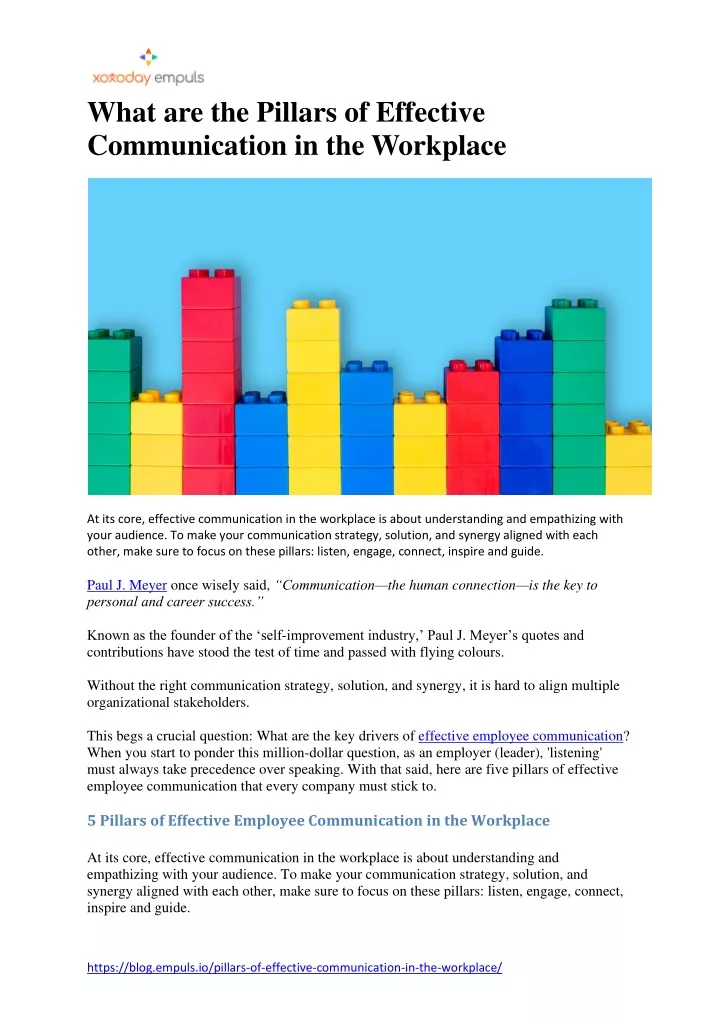
What are the Pillars of Effective Communication in the Workplace
Oct 11, 2023
0 likes | 49 Views
At its core, effective communication in the workplace is about understanding and empathizing with your audience. To make your communication strategy, solution, and synergy aligned with each other, make sure to focus on these pillars: listen, engage, connect, inspire and guide.<br><br>https://blog.empuls.io/pillars-of-effective-communication-in-the-workplace/
Share Presentation

Presentation Transcript
What are the Pillars of Effective Communication in the Workplace At its core, effective communication in the workplace is about understanding and empathizing with your audience. To make your communication strategy, solution, and synergy aligned with each other, make sure to focus on these pillars: listen, engage, connect, inspire and guide. Paul J. Meyer once wisely said, “Communication—the human connection—is the key to personal and career success.” Known as the founder of the ‘self-improvement industry,’ Paul J. Meyer’s quotes and contributions have stood the test of time and passed with flying colours. Without the right communication strategy, solution, and synergy, it is hard to align multiple organizational stakeholders. This begs a crucial question: What are the key drivers of effective employee communication? When you start to ponder this million-dollar question, as an employer (leader), 'listening' must always take precedence over speaking. With that said, here are five pillars of effective employee communication that every company must stick to. 5 Pillars of Effective Employee Communication in the Workplace At its core, effective communication in the workplace is about understanding and empathizing with your audience. To make your communication strategy, solution, and synergy aligned with each other, make sure to focus on these pillars: listen, engage, connect, inspire and guide. https://blog.empuls.io/pillars-of-effective-communication-in-the-workplace/
1. Listen The HSBC Exchange meeting (internally called ‘Shut Up & Listen’) stands as a testament to brands executing a successful communication program. On the surface, it may seem like a program for the employees, but it was instead made for the senior management members. Asking the leaders to put a sock in it, the program's motive was for the leaders to listen to the employees. So the internal communications team opened a direct line of communication between the leadership and the staffers. In a much-needed program to regain employee trust, senior members were not allowed to interrupt, correct, deviate or counteract the employees. The leadership members were only allowed to listen, take notes, and provide an update over the internet after the program. In an exercise with less than ten people in each team, every employee got a chance to directly raise their concerns & grievances without the fear of retaliation or repercussions. Classic deployment of a ‘skip-level meeting,’ employees discussed compensations to grievances in the canteen directly with senior leaders of HSBC. You may capture employee feedback by organizing skip-level meetings (mentioned in the case study above), reverse townhalls, open discussions, leadership chats, Q&A, polls, and surveys. https://blog.empuls.io/pillars-of-effective-communication-in-the-workplace/
As a leader, getting first-hand knowledge and perspective of your employees’ personal and professional lives is helpful and critical for the company. Further down the line, you may measure the change in sentiment via periodic pulse surveys, counting employees who return to the exercise and keeping tabs on public posts on Glassdoor and others. You may use this listening experience and quantitative data to improve and guide future communications efforts. 2. Engage Barclays, the banking & financial services company, has set an excellent example of robust customer engagement via training and communication. The company launched its banking app for Android & iOS but realized that its employees didn't know how to use it. Hence, they could not serve the customers effectively. Being aware of the importance of technology and their native app, Barclays doubled down by launching the Digital Eagles program. The program would fully engage with Barclay's staffers on using the app, getting the most out of the internet, and serving the customers thoroughly. Turning novices into experts, employees received unparalleled training via the Digital Eagles initiative, and results showed a staggering increase from 18 Digital Eagles to 18,000. A classic example of leaders resolving a pressing issue by engaging with the employees, the Digital Eagles initiative shows communicating with employees is vital. When brands test, teach and learn along with employees on the go, you will not only solve the current problem but also future-proof your company. To come up with such ideas or deploy them effectively, you may involve your employees, crowdsource ideas, and create a sense of unity within the organization, which is yet another way to engage your employees. It pays to remember that not everything needs to flow from the central management. It fosters a culture where two-way dialogue across all hierarchies is the easiest way to resolve issues of all scales. 3. Connect Connecting with the employees may seem similar to engaging but wait until you read the mess created by the disconnect between leaders at PayPal and their employees. David Marcus, the former president of PayPal, made an erroneous judgment of giving an ultimatum to his employees. Upon learning that many of his staffers were not using the PayPal app, David took the megaphone approach of asking his staffers to use the app or quit. https://blog.empuls.io/pillars-of-effective-communication-in-the-workplace/
“If you are one of the folks who refused to install the PayPal app or if you can’t remember your password, do yourself a favor, go find something that will connect with your heart and mind elsewhere”— David Marcus. After the memo above was leaked to the press and became a public spectacle, PayPal went back to the drawing board to discover why their employees did not use the PayPal app. David and the rest of the senior management members learned the hard way that people need to feel connected and be a part of the conversation in order to be motivated at work A disconnect that paved the way for the president to send a memo of ultimatum to the employees, the problem can be entirely mitigated with just enough effort and insight. Efforts such as providing a social platform for the employees to connect, celebrate events, speak to peers, reach out to superiors, and share grievances go a long way. Creating community groups for people with similar interests (related and unrelated to work) can do wonders. 4. Inspire Once upon a time, a small town footwear brand ‘Clarks’ hit big by deciding to operate globally. With a significant turnover of over 1.5 billion and four major branches, Clarks was gearing up to become a global contender with a ten-year plan. A plan that may be easily foreseen by visionaries, but small-town employees at Clarks struggled to fathom this magnanimous growth. What Clarks did next was nothing short of ingenious—they made a movie. Taking care of two problems at once, this movie made it easy for the employees to visualize the organization's future and worked as a marketing campaign to start a global conversation. The beauty of this campaign is that Clarks’ employees participated in making the movie, breaking away from the corporate routine. Creative teams made props, other staffers recorded voiceovers, starred as leads, and the in-house intranet and DVDs were also used in the making. By getting creative, leaders may put up a compelling case and inspire the workforce to fall back in line with the brands’ purpose and goals. If the leaders manage to tap into employees' emotions, you have truly inspired them. 5. Guide Employees who are logically and emotionally invested in your company often ponder ‘what’s next.’ This is especially true when your workforce is returning to the office post-pandemic. It is the leader's responsibility to handhold the employees and navigates them with the help of the company’s principles and values. Providing them with the necessary guardrails in the due process may also help. https://blog.empuls.io/pillars-of-effective-communication-in-the-workplace/
Many global giants defined clear sets of guidelines to shape the future of their organizations as they returned to work. You may make the most of the situation and realign the brand’s vision if need be. Effective Communication is the Key to Employee Engagement For every employer, EVP (Employer Value Proposition) is one of the big priorities and to get this right, every company invests millions every year. This could be anywhere from learning & development programs to total rewards to strengthen the employer-employee relationship. And this investment is increasing year on year. Yet, this Gallup’s study says that 74% of the employees are either watching for new job openings or actively looking for other employment opportunities. Despite employers' increased attention and spending on EVP, employees aren’t still recognizing the value. So why is there a major disconnect between a company and its employees? Well, the answer is simple: the message is not getting through. Employee communication is broken, and the reasons are apparent Today, the way we work, and the workforce itself, have changed dramatically. There are 5 generations at work. Interestingly, millennials will make up 75% of the global workforce by 2025, and they are already the largest cohort. (Don’t forget: Gen Z is hot on their heels) Consumption of information has changed. Traditional workplace communication methods no longer work in modern workplaces. Today, the way people want to receive information is different. They expect communications to happen whenever and wherever they want it. Also, they want it in a format that’s familiar, easy to consume and not overwhelming. The solution: Have a tool that drives employee engagement via communication A company's success entirely depends on its employees' understanding of the value it provides. Hence, an effective communication strategy is vital to accomplishing that. Employee communication today demands meeting your people where they are—which means reaching them in a format that resonates with them. By understanding company-to- employee communications better, you can make your workplace more productive. This infographic breaks down effective employee communication into four groups, and when done right, it can drive engagement. https://blog.empuls.io/pillars-of-effective-communication-in-the-workplace/
https://blog.empuls.io/pillars-of-effective-communication-in-the-workplace/
Conclusion With everything said and done, companies of all scales and industries require a comprehensive employee communication strategy. While the key drivers to it mentioned in this article will undoubtedly come in handy, they are just the tip of the iceberg. A cohesive work culture where both a fresher and the company's CEO has the same vision in mind is a dream, and effective deployment of communication strategy is the easiest way to achieve it. https://blog.empuls.io/pillars-of-effective-communication-in-the-workplace/
- More by User
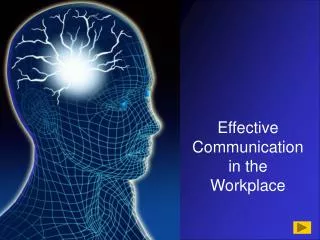
Effective Communication in the Workplace
Effective Communication in the Workplace. About your facilitators. Brenda Watkins, Trainer, Special Projects
2.33k views • 54 slides

Interpersonal Communication in the Workplace
Interpersonal Communication in the Workplace. Based on Chapter 7, Goodall and Goodall Lynne Dahmen. COM 2301: Advanced Speech. How do we make first impressions?. Perceptions (appearance, voice, language use) Schemata Person Prototypes Personql Constructs Scripts/phatic communication.
2.51k views • 34 slides

Intercultural Communication in the Workplace
Culture. Learned patterns of behavior and attitudes shared by a group of people - languages, practices, beliefs, values, rituals, and relationships. Learned Behavior. Cultural Identities. Who are we?How are we influenced by cultures we belong to?. Personal Space. Bubble size depends on your cultur
787 views • 15 slides

Communication in the Workplace
Unit 4. Communication in the Workplace . Facilitator Support Materials for Communication in the Workplace . Unit Aim. The aim of this unit is for learners to develop knowledge, understanding and the skills required for effective communication in the workplace. .
936 views • 16 slides

Intercultural Communication in the Workplace. Intercultural Communication Challenges. Communication dependant on cultural upbringing On autopilot Use symbolic systems learned as children to understand messages Use their own cultural norms. Intercultural Communication Challenges.
1.94k views • 32 slides

How are professionals using communication technologies in the workplace?
How are professionals using communication technologies in the workplace? . Class interview project HU3840 Organizational Communication Spring 2010. Interview Guidelines. Defining a professional S alaried employee or licensed contractor Position requires specialized education
360 views • 21 slides
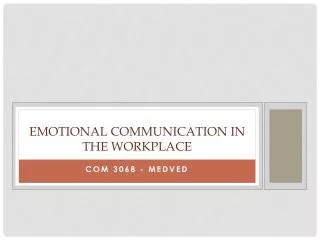
Emotional Communication in the workplace
Emotional Communication in the workplace. Com 3068 - Medved. Rational/logical and emotional. What assumptions do you make about how people act and/or interact in the workplace? Do you assume that workers behave logically and/or rationally in the workplace?
411 views • 8 slides

What are the five pillars of Islam?
bellwork. What are the five pillars of Islam?. 5 minutes. The Spread of Islam. Read Section Ch. 9 . 2 Daily Quiz Ch.9.2 Notes x3 Trace, label, color Map on page 209 Extension: Brochure. The Spread of Islam. __________ was chosen as Muhammad’s successor- or __________.
220 views • 11 slides
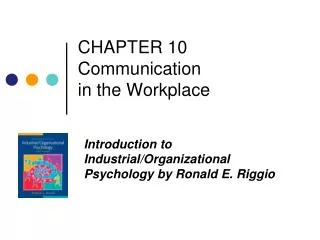
CHAPTER 10 Communication in the Workplace
CHAPTER 10 Communication in the Workplace. Introduction to Industrial/Organizational Psychology by Ronald E. Riggio. The Communication Process: A Definition and Model. Communication is the passage of information between one person or group to another person or group.
2.28k views • 25 slides

Effective Communication in a Culturally Diverse Workplace
Effective Communication in a Culturally Diverse Workplace. Dr. Linda Beamer California State University, Los Angeles. Understanding Unfamiliar Cultures. Using a culture-general approach Values orientation Behavior comparison Overcoming Bias and Stereotypes the threat of the unknown
1.24k views • 37 slides
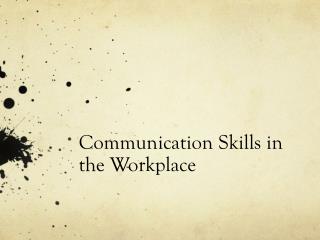
Communication Skills in the Workplace
Communication Skills in the Workplace. What Does “Communication Skills” Actually Mean?. Non-verbal communication skills (NVCS) refers to the ability to convey a message without words through facial expressions, body language, eye contact, etc. http ://www.youtube.com/watch?v=VfDWQG47pAQ
2.78k views • 26 slides
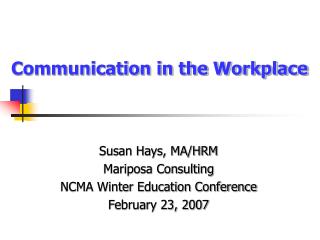
Communication in the Workplace. Susan Hays, MA/HRM Mariposa Consulting NCMA Winter Education Conference February 23, 2007. Miscommunication is the Norm.
1.7k views • 30 slides
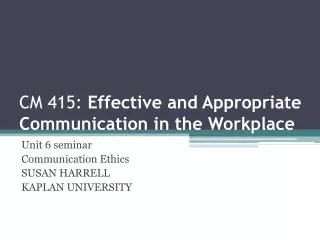
CM 415: Effective and Appropriate Communication in the Workplace
CM 415: Effective and Appropriate Communication in the Workplace. Unit 6 seminar Communication Ethics SUSAN HARRELL KAPLAN UNIVERSITY. Project: Unit 6.
439 views • 21 slides

Communication in the Workplace. Good communication is a key part of success in the workplace. Without communication skills we are unable to let others know what we think, feel, or want to accomplish. We are unable to build partnerships, motivate others, or resolve conflict. .
7.22k views • 59 slides

Communication in the Workplace. Ms. Smith. What is Communication?. Communication is the process of exchanging messages between a sender and receiver. In order to have communication skills, you must be able to: Listen Read Speak Write. Channels vs. Media….
861 views • 19 slides

The 4 Pillars of Effective Digital Marketing
Why isn't your sparkly new website pulling or converting? There are 4 indispensable pillars of effective digital marketing. It's time to understand how to put them to work for your business. Download this free eBook by Barry Feldman of www.feldmancreative.com
1.82k views • 25 slides

What are the objectives of communication
For Assignment Solution Contact Casestudyhelp.in https://www.casestudyhelp.in 9422028822 Business Communication 1. What are the objectives of communication? 2. Explain the different types of listening. 3. Discuss in brief the C’s of Communication. 4. What is agenda? 5. Discuss the importance of formal communication. 6. ‘A good system of communication makes use of both oral as well as written means of communication’. Comment. 7. What is non-verbal communication? 8. Draft a letter of complaint on behalf of M/s Ruchi Enterprises of Delhi to M/s Superior Industries, Mumbai regarding the inferior quality of certain goods received from them. 9. Discuss the purpose of a presentation. 10. What are the barriers to good listening skills? For Assignment Solution Contact Casestudyhelp.in https://www.casestudyhelp.in 9422028822
70 views • 5 slides

Need Answer Sheet of this Question paper Contact us at [email protected] M: 7019944355
75 views • 5 slides

The Six Pillars of Communication
What does it take for business communication to be successful? Regardless of your role in a business, for your communication to be successful, you must communicate with purpose, know your audience, have the resources in place to transmit your message and have it received without interference. You must also follow an ethical code and the laws that govern communication, work cooperatively to integrate diverse ideas and ensure that the communication of sensitive information is conveyed securely. These pillars of communication include: Purpose, Audience, Resources, Ethics, Collaboration, and Security. Source: https://www.24hourtranslation.com/six-pillars-communication.html
44 views • 1 slides

The five pillars of islam are
About Islam Religion: The five pillars of Islam & Major Sins
20 views • 1 slides

What are the Four Pillars of the ACT Exam?
If you want to pass the ACT test with your desired points then you should know the right strategies which can be provided you by the ACT tutors in Kansas City. Read more...
32 views • 2 slides

What Are The Important Pillars Of Digital Marketing Success?
Coming to digital marketing, it includes several strategies. The current presentation is all about the different components of digital marketing which empowers it. To know more, visit - https://techievolve.com/services/digital-marketing-services/
92 views • 8 slides
Join for Free ›
- Career Corner
- Admin of the Month
- Professional News
- ASAP Circle
- Enroll Now →
- Go to My E-Learning Center
- Recertification
- Online Courses + Workshops
- Our Experts
- Partnership Directory
- Advisory Board
- Partnering with ASAP
- Help Center
FREE Weekly Resources
NEW — Admin Month 2024 is here! Learn More › Community Spotlights › -->

Onboarding New Employees: Best Practices for a Hybrid Workforce
August 20, 2024.
The workplace has evolved beyond the traditional 9-to-5 schedule and daily commutes. Many businesses now use hybrid work schedules to improve work-life balance, increase flexibility, reduce commuting time, and access a more diverse talent pool. However, hybrid work presents challenges like communication barriers and a lack of cohesion. Effective onboarding of hybrid employees is crucial for increased retention, satisfaction, and productivity. Here are actionable tips to set clear expectations and optimize your onboarding process.
Effective Onboarding Strategies for New Hybrid Employees
Prepare a comprehensive onboarding plan.
Structured and Tailored Plan: Create a detailed orientation schedule covering the first few weeks, incorporating virtual and in-person meetings. Include clear and accessible instructions for both remote and on-site tasks.
Digital Welcome Packet: Prepare a digital welcome packet with company policies, contact lists, and an employee onboarding checklist, accessible from anywhere.
Resource Accessibility: Ensure new hires can access all required resources and tools, regardless of their work location.
Utilize Technology Effectively
Leverage Digital Tools: Use digital task managers or a company-specific onboarding platform to streamline the process.
Communication Platforms: Familiarize new employees with preferred communication platforms such as Zoom or Microsoft Teams for virtual meet-and-greets and training sessions.
Hardware and Software Check: Confirm new hires have the necessary hardware and software for their roles.
Foster Connection and Inclusion
Virtual Team-Building: Implement virtual team-building activities and icebreakers, such as virtual escape rooms or online trivia games, to help new hires get to know the team.
Mentorship Programs: Pair remote and on-site employees with a mentor who can provide support and guidance.
Informal Communication Channels: Designate channels for informal communication, like dedicated Slack groups for virtual coffee breaks to encourage interaction beyond work tasks and develop a sense of community.
Communicate Expectations Clearly
Define Roles and Responsibilities: Clearly define roles, responsibilities, and performance expectations during onboarding.
Provide Evaluation Templates: Give new employees evaluation templates so they understand the performance expectations of their role.
Set Communication Guidelines: Establish communication protocols, including proper etiquette and response times across preferred channels.
Regular Check-ins: Schedule regular check-ins and feedback sessions. Use a 30-60-90 day check-in schedule to understand how employees feel, what tasks they enjoy, and where they need support.
Optimize Your Onboarding for Success
Break away from traditional onboarding processes and adopt strategies tailored for hybrid employees. For more methods to improve your procedures, watch our webinar on Onboarding and Retention for Virtual and In-Person Teams hosted by Kristine Goebel, an expert on employee engagement in hybrid work environments.
Join the Conversation
Welcome to the ASAP Circle, a community platform for peer-to-peer conversation on trending topics, professional challenges, and shared experiences. We even have designated spaces for weekly Tuesday Coffee Breaks.
Start Connecting Today!
Explore More
- Communication
- Efficiency & Skills
- Professional Development
Join ASAP for Free ›
Advertise with us ›
Financial Reporting: How Admins Can Support Advisors in Preparing Client Reports
Presentation strategies for executive assistants: ensuring a smooth delivery, how to master time management, making messages stick: how to promote ideas that people pay attention to, enhancing communication and support for a better student experience.
Get your free
ASAP Newsletter
Discover the
ASAP Advantage
American Society of Administrative Professionals
Producer of
- Help & FAQs
- Sponsorships
- Terms & Conditions
- Administrative Professionals Conference
- PACE Certification
- Career Center
- Privacy Policy
- DSAR Requests / Do Not Sell My Personal Info
- Terms of Use
- Events, Products, & Services
More From Forbes
The power of storytelling in career advancement.
- Share to Facebook
- Share to Twitter
- Share to Linkedin
Tim Madden is an Executive Coach and former Headhunter. Founder of Executive Career Upgrades , he's on a mission to help accelerate careers.
What makes for an effective executive? Some may say it’s the ability to lead through conflict and change. Others point to a history of successful projects and growth within a company.
Yet, if you gathered some of today’s most revered executives into one room and left them to their own devices, I believe you would find one trait they all share: storytelling.
As an executive career coach who has helped guide executives through different phases of career advancement, I've seen firsthand how mastering the art of storytelling can be one of the most powerful tools in your vocational toolkit.
Sure, some are born storytellers. But this is a skill you can—and I’d argue must— learn if you want to grow in a competitive space.
Trump Vs. Harris 2024 Polls: Harris Leads By 3 Points Halfway Through DNC
Nicolas cage’s ‘longlegs’ gets digital streaming premiere date, ‘institutions are coming’—$35 trillion u.s. dollar collapse predicted to trigger a bitcoin price boom to rival gold, humans are storytellers.
Human beings are wired for stories. We've been sharing them around campfires for millennia, and that fundamental aspect of human nature doesn't change in board rooms and job interviews.
Stories capture attention, evoke emotions and make information memorable in a way that dry facts and figures simply can't match.
In the context of your career, storytelling empowers you to craft a mission, share a vision and rally internal teams and external stakeholders to make bold moves. It doesn’t matter what industry you are in; being able to tell a story that inspires action is powerful.
And when it comes to using storytelling to advance your career, you can use the same frameworks that inspire others to action to compel hiring teams to choose you for their open leadership roles.
The Elements Of A Powerful Career Story
1. a clear, authentic arc.
Every good story has a beginning, middle and end. In your career narrative, this could translate to:
• Beginning: The challenge or opportunity you faced
• Middle: The actions you took and the obstacles you overcame
• End: The results you achieved and the lessons you learned
Your story must be genuinely yours. Authenticity builds trust and connection . Don't be afraid to show vulnerability or discuss failures—as long as you frame them as growth opportunities.
2. Relevance To Your Audience
People enjoy stories that they can relate to. It’s the "Oh, you too?" feeling we get when we get lost in someone’s personal life experience.
Tailor your story to resonate with your specific audience. What matters to them? What problems are they trying to solve? Your story should align with these while staying true to you.
3. An Emotional Connection
While data matters (especially in hiring), emotions ultimately drive decisions. Your story should evoke feelings: inspiration, excitement or a sense of shared purpose. We look for heroes who save victims, acts of great courage and moments of justice defeating evil.
Crafting Your Career Narrative
So how can you infuse these storytelling elements into your own career story?
1. Identify Your Key Themes: What are the recurring themes in your career? Leadership, innovation, problem-solving? These themes will form the backbone of your story.
2. Highlight Climactic Moments: Think about the turning points in your career. These could be challenges you overcame, risks you took or insights that changed your trajectory.
3. Quantify Your Impact: Weave concrete results and data points into your story. Numbers add credibility and punch to your narrative.
4. Show, Don't Tell: Instead of saying you're a great leader, tell a story demonstrating your leadership in action.
5. Practice And Refine: Like any skill, storytelling improves with practice. Refine your stories based on the reactions and feedback you receive.
Applying Storytelling In Various Career Contexts
Job interviews.
Use storytelling to bring your résumé to life . When asked about your experiences, don't just recite facts. Paint a picture of the situation, your actions and the outcomes.
For instance, instead of saying, "I led a team that increased sales by 30%," tell the story of how you identified an untapped market, motivated your team to take on a challenging new strategy and led them on an exciting journey to exceeding your targets.
Networking Events
Events are great for practicing your storytelling chops. Have a few well-crafted stories ready for networking situations. These should be brief but impactful, designed to spark interest and further conversation.
Presentations And Pitches
Use stories to bookend your presentations. Start with a relevant anecdote to grab attention and end with a story reinforcing your key message.
Leadership Communication
As a leader, your stories can inspire, motivate and align your team. Share stories that embody your company's values or vision for the future, and place the hearer into the story themselves.
Tips For Developing Your Storytelling Skills
• Study Great Storytellers: Pay attention to how effective leaders in your industry use stories. What makes their narratives compelling?
• Seek Feedback: Ask trusted colleagues or mentors to critique your stories. What resonates? What doesn't?
• Join A Public Speaking Group: Organizations like Toastmasters can provide a supportive environment to practice and refine your storytelling skills.
• Write Regularly: Keeping a journal or blog can help you reflect on your experiences and articulate them more effectively.
Your Story Could Be Your Career Catalyst
In my years of coaching executives, I've seen how powerful storytelling can transform careers. It's not just about climbing the corporate ladder; it's about creating a narrative that gives meaning to your professional journey and inspires others to trust you as their next leader.
Your narrative should grow and adapt as you gain new experiences. Use the insights you glean from these experiences as the material for the next chapter in your career story. Over time, you’ll be amazed at how your storytelling becomes the evidence of a life well lived.
Forbes Coaches Council is an invitation-only community for leading business and career coaches. Do I qualify?

- Editorial Standards
- Reprints & Permissions

An official website of the United States government
Here's how you know
Official websites use .gov A .gov website belongs to an official government organization in the United States.
Secure .gov websites use HTTPS A lock ( Lock Locked padlock ) or https:// means you’ve safely connected to the .gov website. Share sensitive information only on official, secure websites.
News & Events
- Beginners Guide to Crop Insurance
- Past Events
- RMA Latest Announcements
USDA Invests Nearly $4.1 Million in Risk Management Education for Farmers, Including Underserved and Organic Producers
Back to News Releases
WASHINGTON, August 8, 2024 – The U.S. Department of Agriculture (USDA) today announced it is awarding nearly $4.1 million to organizations and outreach efforts to educate underserved, small-scale, and organic producers on farm risk management and climate-smart farm practices. The funding from USDA’s Risk Management Agency (RMA) provides assistance through its Risk Management Education Partnerships for organizations, such as nonprofits and land grant universities, to develop training and resources for producers about risk management options.
“This funding and these partnerships are key to the success of our outreach and education efforts in communities that historically have not had access to training about risk management options. Our Risk Management Education Partnerships are part of USDA’s broader efforts to ensure equity and access to programs,” said RMA Administrator Marcia Bunger during a virtual event announcing the 2024 recipients. “We need to work with growers, and livestock producers to provide them with the training and resources about risk management options and how to apply them to their farming businesses, and these partnerships will help us do just that.”
This nearly $4.1 million investment builds on the $13 million that RMA has already provided in partnerships since 2021. RMA advertised available funding in January 2024 and reviewed 41 applications.
This year’s partnership projects will reach every state in the nation, including eight state-specific, four regional, and three national programs. Out of the 15 organizations receiving funding, six are new partners and nine are current or former partners, including non-profits and university extensions, among others.
One of the 2024 awardees, Right Risk, LLC, a non-profit group dedicated to providing top notch risk management education will continue their outreach work. “The funding we’ve received through our Risk Management Education partnership will allow us to continue outreach to Alaskan producers,” said Jeff Tranel, Owner and Chief Financial Officer for Right Risk, LLC. “We use on-site trainings, recorded presentations, newsletters, one-on-one coaching, printed materials, and the Right Risk Alaska-specific website to educate producers in Alaska about risk management options.”
The 2024 awardee organizations and their projects include:
- Cross Over Community Development – Provides comprehensive educational sessions on production, marketing, financial, legal and human risks geared to small-scale immigrant farmers.
- Georgia Organics – Offers outreach and educational programing to organic and underserved farmers in Georgia about risk management options, business strategies and record keeping.
- Napa Valley Grapegrowers – Provides risk management education to 500 Napa wine grape producers on: climate smart agriculture, organic and specialty crop farming, Crop Insurance 101 and water conservation.
- Oregon Tilth – Increases awareness, understanding, and use of crop insurance and risk management tools by organic producers and those transitioning to organic production.
- Northeast Organic Farming Association – Supports Vermont farmers by increasing their knowledge of climate-smart agriculture, risk management tools and crop insurance.
- Right Risk, LLC – Develops multi-faceted approach to assist Alaskan producers understand and implement crop insurance and risk management strategies to improve their opportunities for success.
- Rural South Institute – Builds resilient farm operations through increased participation in crop insurance and adoption of value-added and climate-smart agricultural practices.
- University of Arkansas – Delivers workshops that support young Native American beginning farmers and ranchers by equipping them with culturally appropriate risk mitigation strategies focused on climate resilience and strengthening local Tribal food economies.
- University of Arkansas, Division of Agriculture – Provides online and in-person Train-the-Trainer workshops, including all 1890 Land Grant Institutions on the fundamentals of federal crop insurance.
- University of Connecticut – Delivers program designed to mitigate financial and production risks through on-farm tours, online classes and a crop insurance decision application tool for producers.
- University of Maine – Educates farmers about mitigating risks due to climate events, pest outbreaks, market changes and poor business skills through increased awareness and understanding of federal crop insurance programs.
- University of Nevada, Reno – Assists producers understanding of existing and emerging federal crop/livestock insurance programs in Nevada and throughout the West while focusing on local and regional food systems.
- RMA Southeast Ambassador – designed to strengthen the agency’s outreach, engagement, and impact within the agricultural community by creating channels for two-way communication and feedback, ensuring programs meet the needs of underserved agricultural communities in 13 states in the Southeast region.
- Tribal Ambassador – designed to strengthen the agency’s outreach, engagement, and impact to better meet the unique agricultural needs of farmers and ranchers within Tribal communities.
- Navigator Learning Platform – partnership with Custom Ag Solutions to strengthen technical assistance to underserved producers by training specialists tasked with providing outreach and technical assistance on key topics related to crop insurance.
More Information
Crop insurance is sold and delivered solely through private crop insurance agents. A list of crop insurance agents is available at all USDA Service Centers and online at the RMA Agent Locator . Learn more about crop insurance and the modern farm safety net at rma.usda.gov or by contacting your RMA Regional Office .
USDA touches the lives of all Americans each day in so many positive ways. Under the Biden-Harris administration, USDA is transforming America’s food system with a greater focus on more resilient local and regional food production, fairer markets for all producers, ensuring access to safe, healthy and nutritious food in all communities, building new markets and streams of income for farmers and producers using climate smart food and forestry practices, making historic investments in infrastructure and clean energy capabilities in rural America, and committing to equity across the Department by removing systemic barriers and building a workforce more representative of America. To learn more, visit usda.gov .
#
USDA is an equal opportunity provider, employer and lender.
Risk Management Agency:
FPAC Press Desk [email protected]

COMMENTS
Sep 03, 2014. 3.56k likes | 7.2k Views. Communication in the Workplace. Good communication is a key part of success in the workplace. Without communication skills we are unable to let others know what we think, feel, or want to accomplish. We are unable to build partnerships, motivate others, or resolve conflict. . Download Presentation.
Engage in the conversation by asking questions. This attitude helps develop key points and keep a fluid conversation. Effective communication practices are essential for any successful team and organization. Organizational communication helps to disseminate important information to employees and builds relationships of trust and commitment.
Generally, though, you should communicate urgent information or instructions, major news or sensitive news such as a promotion or transfer face-to-face. 2. Prioritize Two-way Communication ...
5. Prioritize two-way communication. Listening skills are just as important to communication in the workplace as talking. Part of being a collaborative team member is listening to other people's ideas instead of just trying to put your own ideas out there.
Introduction. Powerpoint presentation wiht activities (see attached PPT file) The original workforce product was funded by a grant awarded by the U.S. Department of Labor's Employment and Training Administration. The product was created by the grantee and does not necessarily reflect the official position of the U.S. Department of Labor.
Workplace communication is the exchange of information between employees in a work environment. This includes face-to-face conversations, emails, chat messages, videoconferencing, phone calls, and other methods used to convey information in the workplace. ... Send out the agenda and other materials that will be discussed, such as presentations ...
Engage in 2-way flow. Being remote can make it easier for employees to check out and disengage. Be deliberate and creative about giving others a role in communication. Ask questions, use polling and ranking tools, and solicit responses in the form of emojis, gifs, or one-word descriptors. 3.
Workplace communication impacts all areas of a business, from interpersonal relationships to productivity to the company culture. Effective communication ensures that messages are relayed clearly and efficiently to increase the likelihood of a positive outcome. ... In a workplace, you are the sender when you give a presentation in a room full ...
Take a moment alone at your desk or a break outside when possible. 12. Prioritise workplace skills. Workplace skills like problem-solving, collaboration, and time management can also enhance communication. These skills require listening, patience, and organisation, which all play a role in sound communication. 13.
Related: How To Communicate Better With Coworkers. 8. Use tone of voice to add clarity. Your tone of voice affects how others interpret your verbal and written messages. When speaking with co-workers, be sure to use a happy and uplifting tone of voice to convey your interest in your conversations with them.
Sales teams often use persuasive presentations to win clients. 5. Problem-solution presentation. A problem-solution presentation aims to aid in decision-making efforts by describing a problem or a challenge and presenting an audience with a solution or a set of solutions.
Your communication style can have a tremendous impact — positive or negative — on your ability to lead teams and organizations. Developing the ability to adapt your style to meet the needs of your team will help to create a positive workplace culture that motivates your team to work together for common goals.
Workplace communication is the exchange of information between employees in a work environment. This includes face-to-face conversations, emails, chat messages, videoconferencing, phone calls, and other methods used to convey information in the workplace. ... Send the agenda and other materials that will be discussed, such as presentations, to ...
Communication in the Workplace. Communication in the Workplace. Good communication is a key part of success in the workplace. Without communication skills we are unable to let others know what we think, feel, or want to accomplish. We are unable to build partnerships, motivate others, or resolve conflict. . 7.17k views • 59 slides
Communication in the Workplace. Communication in the Workplace. Good communication is a key part of success in the workplace. Without communication skills we are unable to let others know what we think, feel, or want to accomplish. We are unable to build partnerships, motivate others, or resolve conflict. . 7.21k views • 59 slides
3 effective communication in the workplace.ppt - Free download as Powerpoint Presentation (.ppt), PDF File (.pdf), Text File (.txt) or view presentation slides online. The document discusses key aspects of business communication in today's global workplace. It covers communicating with internal and external audiences, the benefits of effective communication, and what employers expect.
10 benefits of effective workplace communication. There are several benefits that effective workplace communication provides an organization. These benefits include: 1. Mitigated conflict. Effective workplace communication can help reduce conflict or tension at work. Most conflicts arise due to ineffective communication tactics which lead to ...
The workplace has evolved beyond the traditional 9-to-5 schedule and daily commutes. Many businesses now use hybrid work schedules to improve work-life balance, increase flexibility, reduce commuting time, and access a more diverse talent pool. However, hybrid work presents challenges like communication barriers and a lack of cohesion.
Use stories to bookend your presentations. Start with a relevant anecdote to grab attention and end with a story reinforcing your key message. Leadership Communication. As a leader, your stories ...
Bachelor's degree in Business or Public Administration, a related area, or equivalency (one year of education can be substituted for two years of related work experience) required; plus six years of progressively more responsible management experience; and demonstrated leadership, human relations and effective communication skills also required.
Here are some effective ways to communicate verbally: One-on-one meetings: One-on-one communication will help some team members understand instructions more clearly, especially if the individual is more introverted and uncomfortable in a group setting. Conversations with a group: Open group meetings can include your entire team in an open forum ...
WASHINGTON, August 8, 2024 - The U.S. Department of Agriculture (USDA) today announced it is awarding nearly $4.1 million to organizations and outreach efforts to educate underserved, small-scale, and organic producers on farm risk management and climate-smart farm practices. The funding from USDA's Risk Management Agency (RMA) provides assistance through its Risk Management Education ...